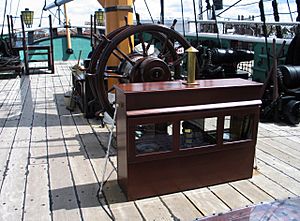Binnacle facts for kids
A binnacle is a special stand or case found on the deck of a ship. It's usually placed in front of the person steering the ship, called the helmsman. The binnacle's main job is to hold important tools for navigation, like the ship's magnetic compass. It keeps these delicate instruments safe and easy for the helmsman to see quickly.
The compass inside a binnacle is often mounted on gimbals. This clever setup helps the compass stay level even when the ship is rocking and rolling on the waves. A binnacle can have different sections and might also hold other items, such as a light source (like an old oil lamp) to see the compass at night. Sometimes, even a sand timer was kept there to help estimate the ship's speed.
You might also hear the word "binnacle" used for the cluster of instruments and switches found near the steering wheel in some cars.
What's in a Name?
The word "binnacle" comes from an older word, bittacle. This word came from the French word bitacle, which means a small dwelling or house. It's a fitting name for a little home for a ship's important tools!
A Look Back in Time
In the past, around the mid-1700s, people didn't realize that the iron nails used to build binnacles could cause problems. These iron nails would actually mess up the readings of the ship's compass! This is because iron can affect a compass's magnetism.
As people learned more about compasses and how magnetism works, they started building binnacles more carefully. They wanted to make sure no iron was near the compass that could disturb its readings.
When ships started being built with iron hulls (instead of wood), the compass problems became even bigger. To fix this, inventors came up with ways to correct the compass. They would place special iron or magnetic objects near the binnacle to cancel out the ship's magnetic pull.
In 1854, an inventor named John Gray created a new type of binnacle. It had special magnets that could be adjusted to help correct the compass. Later, in the 1880s, a famous scientist named Lord Kelvin improved this system even more. He added two special metal spheres to the sides of the binnacle. These spheres, often called "Kelvin's balls," help make the compass readings super accurate.
The Royal Maritime Museum in Greenwich, London, has a huge collection of old binnacles.
You might also hear the term "binnacle list" on a ship. This is simply the medical report of sailors who are in the sick bay and excused from their duties for the day.
See also
 In Spanish: Bitácora para niños
In Spanish: Bitácora para niños
- Gyrocompass
- Logbook



